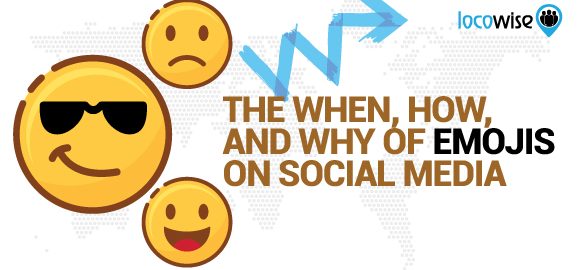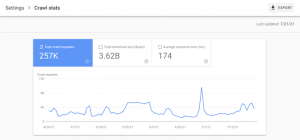Internet-speak has a way of creeping into everyday language.
For the first time ever, in 2015, the Oxford Dictionaries Word of the Year was a “pictograph” – what you probably know to be an “emoji”.
Officially called the “tears of joy”,  is now recognised as the “word” that was said by Oxford to best “reflect the ethos, mood, and preoccupations of 2015.”
is now recognised as the “word” that was said by Oxford to best “reflect the ethos, mood, and preoccupations of 2015.”
Does your brand even emoji?
Here’s why you should, where you should, and how to get these important little pictographs right every time.

A Short History of the Emoji
The term “emoji” is borrowed from the Japanese “e” (for picture) + “moji” (letter, or character).
It’s believed that emoji were first used in early chat rooms in the early 90s, where symbols were used to express thoughts and feelings using fewer characters. Emoji use exploded more recently with the advent of messaging services like WhatsApp, where using an image of a facial expression to convey a thought is a quick and a useful way to help understand the tone of the speaker.
It’s important to know that, while “emoji” and “emoticon” are often used interchangeably, there is a difference: an emoticon is what happens when you type characters into your phone to create a symbol of, for example, a smiley face that looks like this: :). An emoji is an image your phone uses based on what you type into your keyboard – it’s a picture, essentially.
Emojis Today
Today emojis aren’t reserved for chat groups and messaging services, and it’s not just teenagers or young adults using them.
“Olds” use emojis too, as do brands and politicians.
It doesn’t always work, as in this pre-election Twitter post via @HillaryClinton in 2015. She still went on to create the Hillarymoji, which consists of a cartoon of Clinton in an “H” superhero costume. It was not notably successful.
.@HillaryClinton You know what people who went to college can use? Words.
— Louisa (@LouisatheLast) August 12, 2015
Paying attention to your audience is everything, and Kim Kardashian has done this, having launched a successful Kimoji keyboard available on iTunes and that works on iOS8 and higher.
The paid app is not recommended for children, and includes, unsurprisingly, emojis modelled after the reality star.
American athlete Steph Curry and Drake’s father have also produced their own line of emojis.

Emoji Controversies
It pays to use caution when using emojis. Seeming to lack cultural sensitivity can land you in hot water. There’s a good argument for Apple being frontrunners in spreading the wide use of emojis and they have a long history of updating them in order to cater to as broad a market as possible.
Here’s a quick summary of some key changes they’ve made over time:
- 2012 – a gay and lesbian couple holding hands were added to their set of emoticons
- 2014 – the company included emojis with African American faces
- 2015 – users could hold down emojis and choose the skin tone they preferred for them
- 2016 – Apple embraced gender diversity, with new emojis featuring more on female athletes, for example
Apple’s history in carefully adapting emojis to users’ needs is an important lesson for anyone who uses them as part of their digital marketing – whether on social media or in mailers.
Before Looking Into Emojis, Look At Your Brand
Your brand CI is the first place to look if you’re not sure about using emojis. Think about:
- 1. Your brand colours. Is your brand a deep and serious blue? Is it a fun orange and purple? Would emojis match your colours and design tone?
- 2. Your verbal tone. Are you formal in all of your communications? Are you less formal on social media? Do you aim to strike a balance?
- 3. Your product or service. This will tie in with the rest of your CI. Very few people appreciate an emoji from a bank, whereas lifestyle media, health products, and offerings with a “friendlier” approach to the consumer may be perfect for the inclusion of emojis.
- 4. Don’t feel limited. There are more emojis out there to choose from than faces and people, so be creative.
- 5. Experiment. Check your analytics on social media posts, across platforms, that have emojis versus those that don’t. Remember that Instagram can and should be measured
Humanise Your Business
When brands start using emojis, they start humanising their business. People want to feel like they’re talking to real people online, whether they’re on Twitter or Instagram, and nothing says “real” like a well-placed emoji. If you’d like to get more creative, use emojis to express in a character or two what might take two sentences to say.
Think of using an emoji of a pair of shoes with the copy “50% Off”. You’ll have saved space, and saved the reader time. Very few people read all of the copy on social media posts and ads, so less is often more if you want to get your message across effectively.
The Bigger Picture
According to our research, Instagram seems to be the platform that is most emoji-friendly. An analysis of a number of comments showed us that 69% of all emojis were used on Instagram, 15.6% on Twitter and 15.4% on Facebook. The 50 most used emojis account for 78% of all used.
If your Instagram community is using emojis, you might want to join in so that you’re “speaking their language”. The same goes for every platform, as long as you’re aware of your consumer’s demographics, needs, and expectations of you as a brand.
Where Emojis Do And Don’t Belong
#1 Instagram = Emoji Heaven
Sixteen-year-old Jannik Obenhoff has 519,000 followers on Instagram, earning money for his nature photography through sponsorships. Many of his images are titles with emojis, echoed by his fans’ responses.
Instagram naturally lends itself to emojis if Instagram is understood as an art form in the world of social media. For the best brands and users, creating artistic content for Instagram is incredibly important.
Artistic Instagram posts should hopefully illicit emotion in the viewer, who is then more likely to respond emotively – that is, with an emoji. Encourage this by adding emojis of your own: just remember, smiling face emojis are not the only way to tell the consumer your story.
#2 Emojis on Facebook and Sentiment
Facebook has so many emojis available to users that the web is full of lists for people who take emojis seriously enough to want a lot of variety. Next to Snapchat, Facebook is probably the most emoji-friendly social media site.
Its popularity as a platform is more than impressive – by the third quarter of 2016 it had had 1.79 billion users active monthly. If you use Facebook as a brand, it is probably the second-friendliest place to make use of emojis (next to Instagram).
If you’re gauging your Facebook page for sentiment, and you should be, a relatively recent update to the way people respond to posts is incredibly useful. It started rolling out in February 2016 and is now available to all Facebook users.
Facebook CEO Mark Zuckerberg argues that a “like” isn’t right for every situation, so generic “likes” have been replaced with “reactions”. Make sure your social media analytics engine takes this into account so that customer sentiment can be learnt from and new ideas implemented as necessary. An angry face reaction to a post says a lot.
Locowise goes a step beyond this in our sentiment analysis. Take a free trial to analyse your brand (and your competitor) sentiment on post, page and brand levels.
#3 Is Snapchat For You?
More than 100 million people use Snapchat today. The platform is still dominated by young people, with 60% of users being under 25, and a quarter not yet having graduated from high school.
Three years ago, very few people over 25 were using the app. Marketers are watching it closely, but they’re watching it cautiously and you may want to do the same. Here’s a list of Snapchat emojis and their meaning if you’re curious about the platform.

#4 The Twitter Question
The rules of engagement when it comes to Twitter are exactly the same as those that apply to looking at your brand CI before doing anything new with your social media strategy (see above).
Emojis are used by brands on Twitter, but not as widely as on other platforms. This could have to do with Twitter demographics – users tend to be older and resistant to sponsored content – and what the platform is usually known for sharing.
As of today, Twitter isn’t the best place to advertise. Roughly one-quarter of online adults (24%) use Twitter, which has barely unchanged from a Pew Internet survey conducted in 2015 (23%).
According to the same research, around 36% of adults ages 18-29 are on Twitter, more than triple the number of adults ages 65 and older who are online (just 10% of whom are Twitter users).
Twitter tends to be more popular with the highly educated, and 29% of users have a university education. Twitter users may be resistant to sponsored ads (and research shows repeatedly that they are) but it is, however, an excellent customer service channel.
If you do customer service with a smile, feel free to add the occasional smiley face to a tweet when appropriate. Use emoji on Twitter with discretion, but don’t rule them out completely.
The Take Away
If you haven’t used emojis before and you think they might be right for your brand, business, or service, make sure you track your progress. Just as you need a business strategy, you need a social media strategy. Always.
Digital & Social Articles on Business 2 Community(74)








